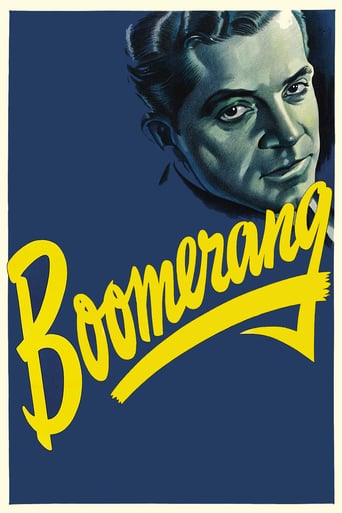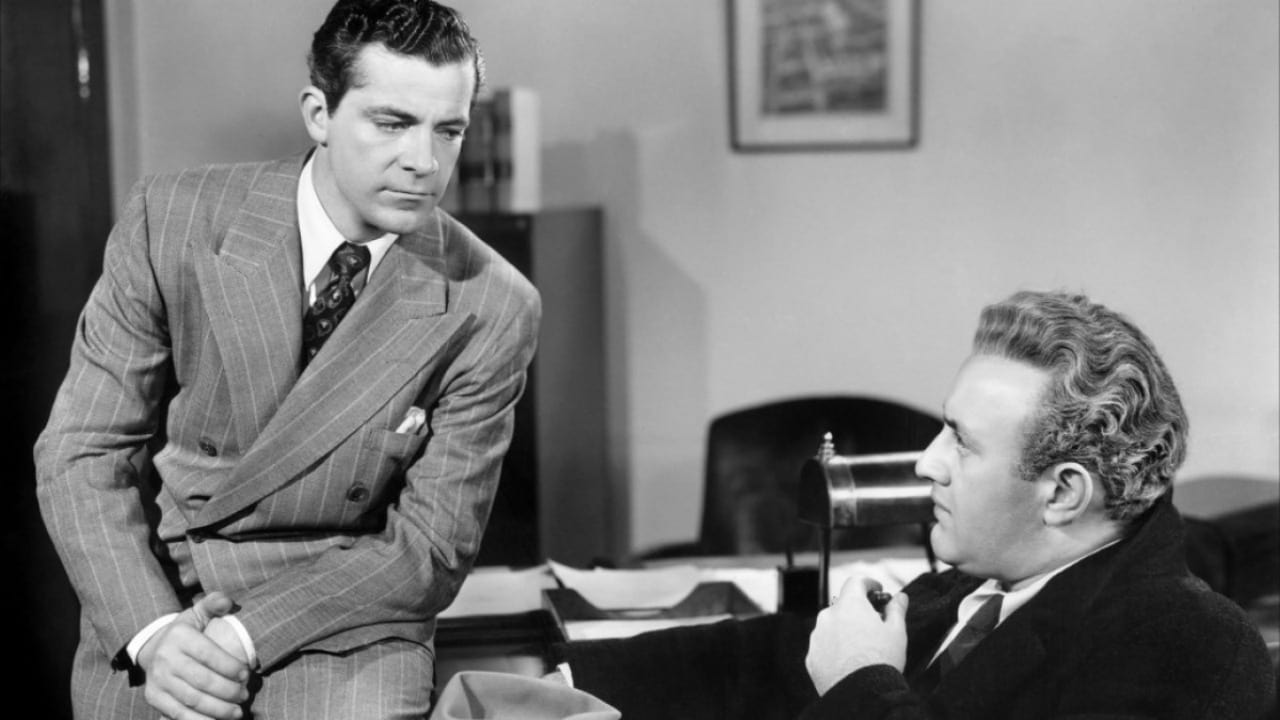JohnHowardReid
Elia Kazan declined to discuss his Fox films when I interviewed him. He felt they were not his. They were not Gadge Kazan movies but the result of a team effort by such superb studio craftsmen as photographer Norbert Brodine and film editor Harmon Jones. True, Kazan directed the cast, but this movie's visual style, pacing and atmosphere was supervised by de Rochemont who had the ear of studio head, Darryl F. Zanuck.However, despite Kazan's initial reluctance to talk about Boomerang!, we actually spent well over thirty minutes on it. While he agreed that the picture was realistic at a time when Hollywood was mainly into glamour and escapism, Kazan argued the movie "was no way as good as Paisa." Kazan was also contemptuous of the over-simplification of civic corruption in Fulton Oursler's Reader's Digest article on which the film was based. And he was not happy with his leading man, Dana Andrews, whom he described as difficult to direct. He didn't like the way Brodine lit the film either and found him extremely unreceptive to suggestions that he employ a more gritty style such as that used by Martelli in Paisa.
disinterested_spectator
It is often said that truth is stranger than fiction. And indeed, there are stories that would be unbelievable if presented as a work of fiction, but succeed because they are based on a true story. It would be a mistake, however, to infer from this that movies are better when they are based on something that really happened rather than based on nothing more than a writer's imagination. And this is because whereas a work of fiction can be structured so that everything is satisfactorily resolved by the end, reality is often messy and incomplete."Boomerang!" is a good example of that. It was made during a period in which filmmakers were on a realism kick, wanting to make movies based on true stories and filmed on location. It begins with a Reed Hadley, semi-documentary, Louis de Rochemont style of narration: "The basic facts of our story actually occurred in a Connecticut community much like this one."Hadley's narration accompanies us through the murder of Father Lambert and the outrage on the part of the citizens of the community. But then we have a flashback of sorts, in which we see Father Lambert dealing with two different men, as narrated by Hadley: "Since he was a man of God, his labors sometimes led him into the strange and secret places of men's souls. He was just and forgiving, but he was also a man and a stern and uncompromising judge of character." The first man, we later find out, is John Waldron, played by Arthur Kennedy. We see Lambert give him something, smile, and pat him on the shoulder. But Waldron angrily turns away, tearing up the piece of paper he was handed. From what we find out subsequently, Waldron was presumably asking for a handout, but all he was given instead was "a lecture and a pamphlet."This is followed by a conversation Lambert has with a second man, in which Lambert tells him that he is sick and needs to be institutionalized: "This time, fortunately, no great harm has been done. But the next time
. No, I can't let you go any longer. It's got to be a sanitarium." Lambert even suggests that the man's mother may have to find out (Gasp!). We never learn exactly what this man has done, but everything points to his being a child molester. The remark about no great harm having been done this time suggests that he was caught fondling a little girl, and Lambert is afraid that the next time the man will go further.At first, this seems strange. We can see that Waldron's anger could be a motive for murder, but that would be quite a stretch. On the other hand, a child molester who is afraid his mother will find out and that he will be put in a sanitarium very definitely has a motive for murder. So, why would the movie tell us who Lambert's killer was right in the beginning? Sometimes murder mysteries do that, however. In the television series "Columbo," we always found out in the beginning who the murderer was, and the fun was watching the cat-and-mouse game played between him and the title detective. So, I settled in with that assumption and continued to watch the movie.The prosecuting attorney, Henry Harvey (Dana Andrews), actually presents evidence that Waldron did not commit the murder, despite all the political pressure and even blackmail brought against him. Throughout the trial, we see the child molester in the courtroom watching with apprehension on his face. Then there is a ridiculous scene in which Harvey has an assistant point Waldron's loaded revolver at his head and pull the trigger in order the prove that the firing pin was faulty and thus the gun could not have been the murder weapon, which is immediately followed by Ed Begley's character committing suicide by shooting himself right there in the courtroom. Somehow I doubt seriously that these are some of the "basic facts" of this "true story."Anyway, Waldron's innocence having been established, he is released. We see the guilty-looking child molester leaving the courtroom, while a savvy reporter, played by Sam Levene, looks at him suspiciously. Later, we find out that the child molester was killed in an automobile crash. He was fleeing from police for speeding, when he suddenly swerved, presumably intending to kill himself. While we are seeing all this, the narrator tells us that the case was never solved.Now wait just a cotton picking minute! In other words, there was no child molester. It was a total fabrication. In its confused way, the movie is admitting that no one ever found out who killed Father Lambert, while at the same time suggesting that somehow or other justice was served. The reason for this piece of baloney is easy to understand. If the movie had stuck to the facts, if all the stuff with the child molester had been edited out, then it would have ended with the unsatisfactory conclusion that while an innocent man was cleared, the guilty man, whoever he was and whatever his motive, was never caught.This movie cheats, trying to have it both ways. It presents its story as based on actual events and filmed on location to give it the aura of authenticity, and then it concocts an imaginary child molester to be the villain so he can be killed off at the end, giving the movie the kind of resolution that we typically have in a work of fiction.
seanparker1942
This is a top-notch Film Noir with some excellent acting all round. It is also helped by a terrific true story line where an accused man is exonerated. And another twist to the story is that the prosecutor assigned to send him to his death is the one who ultimately gets him off. This would not have happened if the local community and its politicians had heir way. As an aside, when Arthur Kennedy is first arrested and is in the police station an officer walks across and places a hand on his shoulder, the man looks like Eli Wallach but there is nothing on his profile to say that it was him Also, he is not mentioned in the cast list for Boomerang. Has anybody else noticed him?
AaronCapenBanner
Elia Kazan directed this true story set in Connecticut, that begins with the mysterious murder of a popular priest that proves quite difficult to solve, until finally a suspect emerges: a drifter named John Waldron(played by Arthur Kennedy) who was known to be in the area, and has no alibi. The police chief(played by Lee J. Cobb) is satisfied with his suspect, but State Attorney Harvey(played by Dana Andrews) isn't so sure, since there is a distinct lack of evidence(a motive in particular) He then decides to defend Waldron, much to the surprise of his town. Effective film with good acting and direction, and a most interesting recreation of this mysterious case and its effect on the community.



 AD
AD




